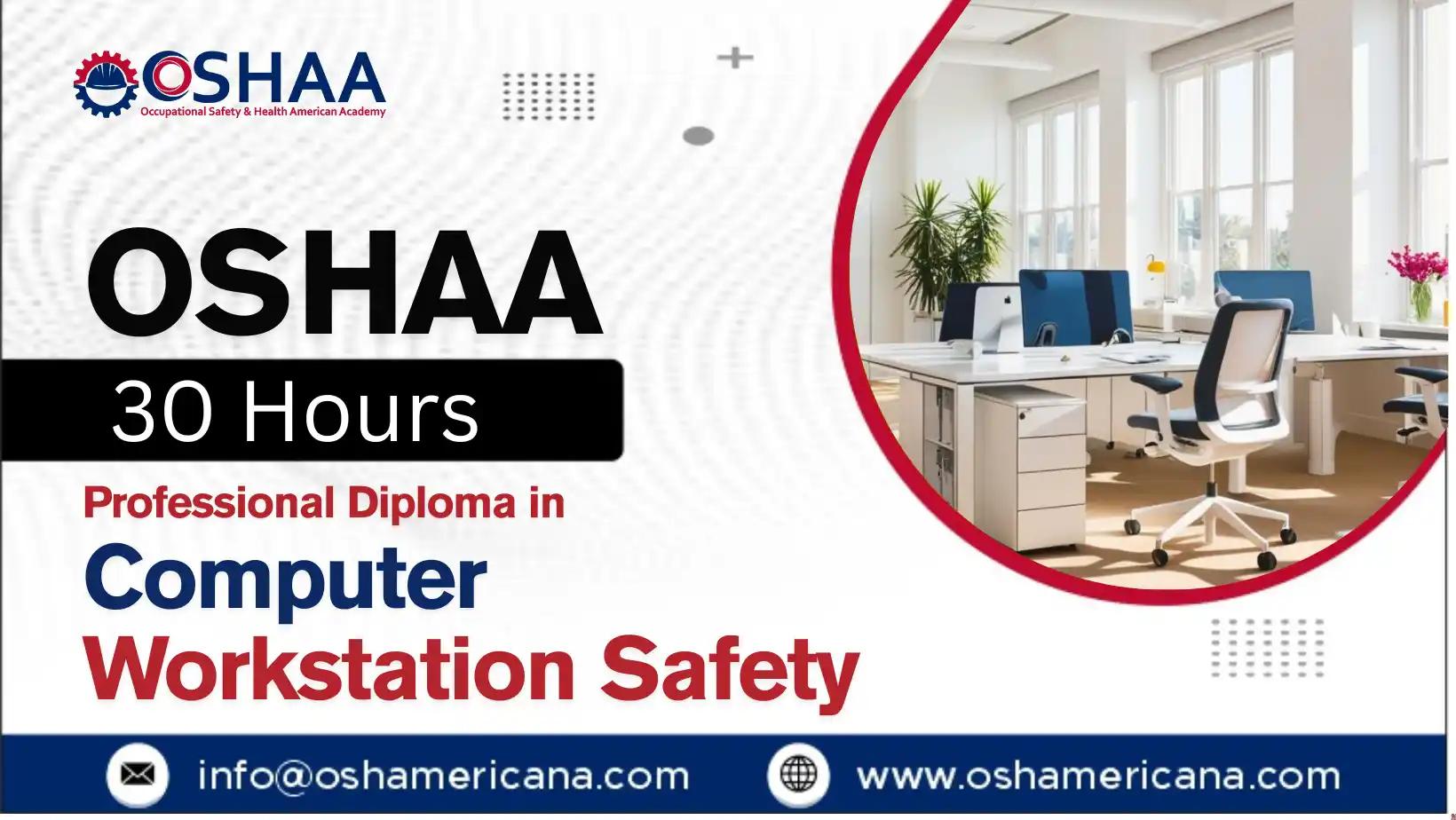In today’s increasingly digital work environment, the importance of maintaining a safe and ergonomically sound computer workstation cannot be overstated. Prolonged use of computers without proper awareness of workstation safety can lead to various physical and mental health concerns, ranging from repetitive strain injuries and musculoskeletal disorders to eye strain and fatigue. Recognizing this need, OSHAA, a globally recognized awarding body, offers the 30-Hours Professional Diploma in Computer Workstation Safety — a comprehensive and practical training programme aimed at promoting safe and healthy work practices in digital environments.
This diploma is designed to provide participants with the essential knowledge and skills to evaluate, manage, and improve workstation ergonomics. By integrating international best practices with evidence-based approaches, this course supports organizations and professionals in creating safer, more productive workspaces.
The OSHAA 30-Hours Professional Diploma in Computer Workstation Safety covers a range of critical areas including ergonomic principles, workstation design, posture correction, equipment adjustment, and the prevention of computer-related injuries. Participants will explore both theoretical frameworks and real-world applications that enable them to assess workstation risks and implement effective safety measures.
This diploma is ideal for participants working in office-based roles, health and safety officers, occupational health professionals, human resources personnel, and those responsible for employee wellbeing. It also benefits those involved in remote work or hybrid work arrangements where personal workstation setup plays a crucial role in health and productivity.
As an internationally recognized awarding body, OSHAA is committed to promoting excellence in occupational safety and health education. With its focus on practical skills, industry relevance, and global standards, the OSHAA 30-Hours Professional Diploma in Computer Workstation Safety is a valuable credential for those seeking to advance their expertise in workplace health and safety.
In an era where digital workspaces dominate professional life, ensuring proper workstation ergonomics is not just a luxury—it is a necessity. This diploma empowers participants to take proactive steps toward safer and more sustainable work environments, benefiting both personal health and organizational performance.
OSHAA 30-Hours Professional Diploma in Computer Workstation Safety
Study Units
Learning Outcomes
Introduction to Computer Workstation Safety and Ergonomics (3 Hours)
- Understand the fundamentals of computer workstation safety and its importance
- Define ergonomics and its role in preventing workplace injuries
- Identify key components of an ergonomically sound workstation
- Recognize the impact of poor workstation design on productivity and health
Anatomy of Musculoskeletal Disorders and Repetitive Strain Injuries (3 Hours)
- Identify common musculoskeletal disorders linked to computer use
- Understand the causes and symptoms of repetitive strain injuries
- Explain the physiological effects of prolonged static postures
- Apply basic knowledge of anatomy to assess ergonomic risks
Workstation Design: Furniture, Equipment, and Layout (4 Hours)
- Evaluate workstation components such as desks, chairs, monitors, and peripherals
- Understand design features that contribute to ergonomic safety
- Apply ergonomic principles to set up and adjust workstation equipment
- Identify potential design flaws that contribute to discomfort or injury
Posture and Movement: Best Practices for Computer Users (3 Hours)
- Recognize the importance of proper posture during computer work
- Demonstrate correct body alignment for seated and standing workstations
- Identify signs of poor posture and associated health risks
- Apply strategies to encourage healthy movement and reduce fatigue
Visual Ergonomics and Lighting Considerations (3 Hours)
- Understand visual ergonomics and its relevance in screen-based work
- Identify the causes and symptoms of digital eye strain
- Assess lighting conditions that affect visibility and comfort
- Recommend improvements for screen positioning and lighting setups
Risk Assessment Techniques for Workstation Safety (3 Hours)
- Learn methods for identifying ergonomic hazards in computer work environments
- Conduct basic workstation assessments using established tools
- Prioritize risks and suggest appropriate control measures
- Document findings and prepare actionable assessment reports
Health and Safety Regulations and Compliance Standards (3 Hours)
- Understand national and international health and safety standards
- Identify key legal obligations for workstation safety in the workplace
- Recognize employer and participant responsibilities in maintaining safety
- Apply compliance strategies aligned with occupational health regulations
Implementing Ergonomic Interventions in the Workplace (3 Hours)
- Design practical ergonomic solutions for common workstation issues
- Understand the process of introducing and evaluating interventions
- Promote user-centered approaches to ergonomic improvements
- Collaborate with stakeholders to support a safer workplace culture
Workplace Wellness Strategies and Break Management (2 Hours)
- Recognize the role of breaks and movement in injury prevention
- Identify effective micro-break and stretch routines for computer users
- Promote mental and physical wellness in digital workspaces
- Integrate wellness strategies into daily work practices
Developing and Promoting a Computer Workstation Safety Policy (3 Hours)
- Understand the components of a comprehensive workstation safety policy
- Learn how to draft, implement, and review safety policies
- Promote awareness and training to support policy compliance
- Evaluate the effectiveness of policies through feedback and monitoring
The OSHAA 30-Hours Professional Diploma in Computer Workstation Safety offers a range of practical and professional benefits for participants aiming to enhance safety and well-being in computer-based work environments. This course is designed to support individuals and organizations in creating healthier, more efficient workspaces by applying evidence-based ergonomic principles.
- Enhances participants’ ability to identify and mitigate risks associated with prolonged computer use
- Equips participants with practical skills to assess and improve workstation ergonomics in various settings
- Supports the prevention of common workplace injuries such as repetitive strain injuries and eye strain
- Promotes a culture of safety, comfort, and productivity in both office and remote work environments
- Improves compliance with occupational health and safety standards and legal obligations
- Increases awareness of posture, movement, lighting, and equipment use to prevent long-term health issues
- Provides recognized professional development for roles related to health and safety, human resources, and workplace design
- Encourages the integration of wellness strategies into daily routines, reducing fatigue and improving focus
- Helps organizations reduce absenteeism and improve employee satisfaction through proactive workstation safety
- Delivers a strong foundation for implementing effective safety policies and ergonomic interventions across industries
The OSHAA 30-Hours Professional Diploma in Computer Workstation Safety is designed for participants who are responsible for, or involved in, ensuring health, safety, and ergonomic standards in computer-based work environments. It is ideal for individuals seeking to enhance their knowledge and skills in workstation assessment, injury prevention, and digital workplace wellness.
This course is particularly suitable for:
- Participants working in office-based roles who use computers for extended periods
- Health and safety professionals aiming to expand their expertise in ergonomics
- Human resources and administrative personnel involved in employee wellbeing
- IT professionals and workstation setup technicians
- Facilities managers responsible for workplace design and layout
- Occupational health practitioners supporting safe work environments
- Remote and hybrid workers looking to optimise their home office setups
- Individuals seeking a recognised qualification in workstation safety and ergonomics
The course benefits participants across various sectors, including corporate offices, educational institutions, government departments, healthcare settings, and remote working environments.







